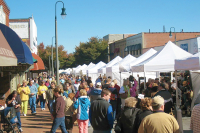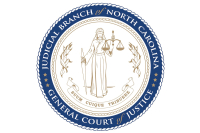Ginkgo — a living fossil
When a street was being cut in front of the new county administration building here in Bryson City back in the 1980s, a large foreign-looking tree could well have been felled in the name of progress. But resident R.P. Jenkins convinced authorities to pave a sidewalk around the tree so that it still stands at the corner of Mitchell and Everett streets as a representative of what has been rightfully called “a living fossil.”
It was a ginkgo or maidenhair tree (Ginkgo biloba). According to information Jenkins was able to obtain from the Foreign Mission Board of the Southern Baptist Convention in Richmond, Va., the Bryson City ginkgo was imported from China in 1941. The tree was planted at its present location by Mary Bryson Tipton, a former Southern Baptist missionary to China who had been forced to leave that country when it was invaded by Japan. She was 85 years old when she passed away in an Asheville hospital in 1963 and was buried near Black Mountain.
Mrs. Tipton’s tree is now approximately 75 feet tall. It displays deciduous leaves that are light green in color before turning a yellow from late September into October. These fan-shaped leaves give the tree its common name “maidenhair tree” because they resemble the foliage of maidenhair fern. Many towns in Western North Carolina have ginkgo trees of their own. A guide I have titled “Three Short Tree Walks in Sylva” was prepared in 1986 by the Sylva Garden Club. At that time, the guide was available at the Jackson County Chamber of Commerce. Of the 40 or so species located in Sylva’s immediate downtown area, one was a ginkgo situated not too far from the corner of Main and Walnut streets.
Ginkgo is not closely related to any living group in the entire plant kingdom, being the sole survivor – “a living fossil” as it were — of a family that was widely distributed during the era when dinosaurs roamed the earth. For centuries it was thought to be extinct in the wild but is now known to grow in at least two small areas in eastern China. However, the trees in those areas may have been tended and preserved by Chinese monks for over 1,000 years as sacred plants — so that whether or not native ginkgo populations still exist remains uncertain.
In the Orient, chessboards and pieces are often made from the wood. The pure white seeds are eaten traditionally at weddings and other social occasions; for which reason, it is considered to be the oldest cultivated nut tree.
The ginkgo was introduced into Europe in the mid-18th century and reached this country from England as early as 1785. It has been most widely used as a street or park tree, but makes a handsome yard ornamental as well. The seeds are easily propagated after stratification. Cuttings can also be utilized. And various hybrid forms are available from nurseries.
Related Items
The extract of the ginkgo leaves contains glycosides and terpenoids and has been used pharmaceutically. It has many alleged poperties but is mainly used as a memory enhancer and anti-vertigo However, studies differ about its efficacy.
Ginkgo trees produce pollen and seed on separate male and female trees. The one here in Bryson City is male, as are most of the ornamental ginkgoes in the United States. Female trees produce a plum-like fruit about an inch in diameter that is attractive but gives off a vile odor after falling to the ground.
Ginkgoes have the curious habit, in mid-fall, of dropping all of their leaves virtually at one time, usually following a heavy rainstorm. One October day the bright foliage will be intact on the graceful spire-like tree; then, the next morning, the ground underneath the bare branches will be carpeted with luminescent yellow.
George Ellison wrote the biographical introductions for the reissues of two Appalachian classics: Horace Kephart’s Our Southern Highlanders and James Mooney’s History, Myths, and Sacred Formulas of the Cherokees. In June 2005, a selection of his Back Then columns was published by The History Press in Charleston as Mountain Passages: Natural and Cultural History of Western North Carolina and the Great Smoky Mountains. Readers can contact him at P.O. Box 1262, Bryson City, N.C., 28713, or at This email address is being protected from spambots. You need JavaScript enabled to view it..









